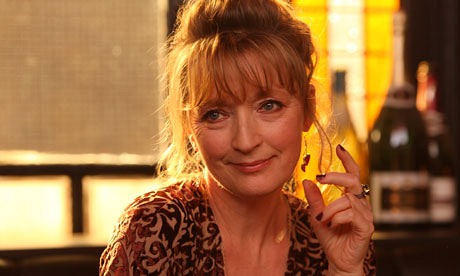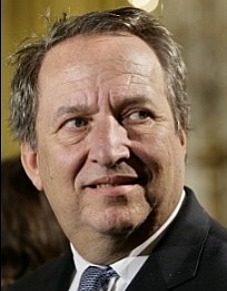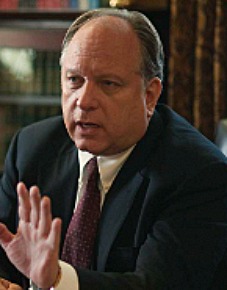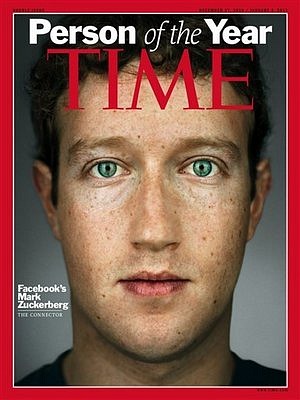Matt Shapiro‘s Cinescape summary is significantly better than that other one. More emotional, a bit more thematic…and I love that roomful of overlapping dialogue at the very beginning. But the Killers’ “Dustyland Fairytale” begins to feel obnoxious after a while, and the piece itself, like the other one, is a little too whizflashbang.
Daily
Down For The Count?
I think it’s finally time to admit that Sony Classics, no offense, flubbed Lesley Manville‘s Oscar chances by putting her up for Best Actress. I’ve been arguing for weeks that the aching heart of Another Year should have been pushed as a Best Supporting Actress contender, but Sony Classics thought otherwise and now it looks like her goose may be cooked.

Another Year‘s Lesley Manville.
Manville won the National Board of Review’s Best Actress award, great, but she hasn’t even been nominated in that category by the Critics Choice, Golden Globes or SAG, which suggests she has a possible outside shot, at best, at an Oscar nomination. I’d love to be proved wrong, but I think it’s highly unlikely that she’ll make it. And if she does, there’s no way in hell she’ll win. But if she’d been put into Best Supporting Actress contention, she’d be a likely Oscar nominee since she would have probably made the cut with the Golden Globes and SAG and BFCA, and there’d be a reasonably good chance that she might actually win the Best Supporting Actress Oscar. What a shame, what a sadness.
This morning I asked some journalist pals if they believe Manville has any kind of shot at a Best Actress Oscar nomination at this stage, and if they believe she might be in a better position if Sony Classics had taken my advice and put her into Supporting instead. Here’s what some said:
Indiewire‘s Anne Thompson: “Manville is clearly a leading actress, so I don’t think [putting her up as] supporting would have made any difference. In the case of [Another Year director/writer] Mike Leigh, the Academy actors take him seriously and check out his films. It’s amazing that he’s landed as many nominations as he has over the years, and for such unlikely candidates as Brenda Blethyn in Secrets and Lies and Imelda Staunton in Vera Drake. Yeah, Sally Hawkins was overlooked but it was a crowded category, as it is this year. The question is, will the Academy voters watch the Another Year DVD? I think the Academy is a classier, tonier group that will also be more likely to watch Blue Valentine, btw.”
Gold Derby‘s Tom O’Neil: “Lesley Manville can uncork a bottle and get blotto with self pity because she ain’t getting nommed at the Oscars — that’s now clear. That lead race is just too packed with A List divas giving big grandstanding roles, pushing Manville out. But I don’t think the Globes would’ve fallen for a ploy of category fraud if Sony Pictures Classics had tried to place her role in supporting. The HFPA eligibility committee is getting tough these days. But at the SAG Awards, the actor decides which category they’re going into. If SPC had entered Manville into supporting, that might’ve worked. Yes, she might’ve gotten nommed and that, in turn, might’ve positioned her for Oscar recognition. That was her only hope. Turns out you were right, Jeff.”
Rope of Silicon‘s Brad Brevet: “My faith in her getting an Oscar nomination has dwindled to the point she may be the last one in. So that would be a ‘no’ to the win. Yes, yes, yes — she should have been in supporting, which is what I wrote about in October. It’s a tragedy in Oscar terms, but at least most everyone I read still continues to talk about her and the performance every time she’s overlooked. So that’s, at the very least, a plus.”
TheWrap‘s Steve Pond: “It’s still possible that the Academy will fix this and nominate her, but are enough voters going to even watch the movie now? I doubt it. I think it really needed some awards and nominations to move it further up in those piles of screeners. Yes, Manville would have been better off in supporting. And unlike the case of The Kids Are All Right, where it would have betrayed the movie to campaign Bening for lead and Moore for supporting, Sony could have made a completely reasonable argument for Manville in supporting. I agree that they blew it here — but let’s face it, the voters are the ones who really blew it. And not just in Manville’s case.”
Awards Daily‘s Sasha Stone: “Fox Searchlight is, quite simply, a better publicity machine than Sony Pictures Classics. I predicted [Conviction‘s] Hilary Swank shortly before the announcement because I figured that Searchlight would have stopped at nothing to make that happen. On top of which Swank is very popular in the SAG. And that voting body doesn’t do well with foreigners: Andrew Garfield, Jacki Weaver, Lesley Manville. Keep in mind that they have a huge membership. They randomly select a ‘nominating committee.’ But they do this in such a fashion that it can’t possibly account for taste. Any old person with a SAG card votes on these. Oscar is much more exclusive and selective. Therein usually lies the difference. But it does show how the acting categories this year are kind of all over the map.”
All I know for sure is that it’s an outrage that Hillary Swank got Best Actress nominated by SAG for Conviction, and not Manville. Congrats to Fox Searchlight for doing a slambang job in getting Swank nominated, but right is right and Manville, I feel, has been cheated out of a completely justified moment in the Oscar sun.
I asked Sony’s Michael Barker and Tom Bernard if they wanted to say anything, but they passed. If I were them I would have said something along the lines of “we loved Lesley Manville’s performance so much that we just couldn’t think of it as anything other than a lead performance. It’s too strong, too penetrating. She’s the essence of that film. Whatever happens Oscar-wise, were enormously proud of her and the entire team behind Another Year.”
Hombres
The three main Fighter guys — director David O. Russell, star-producer Mark Wahlberg and costar Christian Bale — did the Charlie Rose Show last night. What’s Bale’s accent? He sounds like he comes from some kind of naybuhhood.

Christian Bale during last night’s taping.

Soul Man
I saw Ken Russell‘s The Music Lovers (’71) exactly once, but it’s one of my favorite Russell films, despite the tortured and sometimes grotesque tone of it. I’ve certainly never forgotten Richard Chamberlain‘s lead performance, or this performance scene of Peter Tchaikovsky‘s “Piano Concerto No. 1.” No one initially applauds at the end of the performance because they’re too moved, or so I recall.
Here, if you’re interested, is Van Cliburn performing the whole beautiful thing.
Soft Spoken
Last night I attended a NY Times “Times Talk” interview with Times critic Jason Zinoman interviewing Somewhere director Sofia Coppola and star Stephen Dorff. No photos or recording were allowed, but my own interview with Coppola (which happened three days ago at the Standard) was just as good.

I needed earphones to hear this on my Windows Toshiba laptop, but it sounds nice and robust on the iMac.
“I think it’s refreshing for an audience to get to breathe and not feel bombarded,” Coppola said about her film, “and to feel a kind of quiet…not have the same thing all the time. A lot of people tell me they think about it a lot after they’ve seen it, [that] it stays with them.”
Our conversation was all over the map, but it was relaxed and enjoyable, I felt. I chose not to prod or invade with heavy questions. It felt better to just glide through the clouds. “I’m not one of those early morning writers…I’m not a morning person,” she said at one point. “We have a place in Paris [but] my boyfriend’s band, Pheonix, has been on tour in the US, [and] I like being in New York. I always want to do something else [after doing a certain kind of film] but I’m not sure what….but I like doing a film the small way with a small crew. I try to do that, [make a film] every couple of years. I’m usually working on it. I’ll take a little pause to regroup or whatever.”
Houston Screwups
It runs out that HE’s recent TypePad problems were entirely the fault of the goons at HE’s server, Orbit/ThePlanet. “The basic problem was the server time clock began falling out of sync because of a bad motherboard,” HE’s tech guy, Brian Walker , explains. “As the time fell further offbase we began to notice symptoms like TypePad not validating logins because our server said the logins were not happening in real time.
“[But] when the techs gave us a new motherboard they messed up the time reset, making comments that were posted in the last 24 hours have a bad timestamp (3 days in the future). The techs fixed the clock ‘for real’ and we tinkered with the bad comments from the last 24 hours to get everything back up to speed. During that time many people had login problems and others could login and seemingly post, but their posts would not show up on the site due to the server clock. But all should now be well in HE Land.”
More SAG Cluelessness
The Film Experience‘s Nathaniel Rogers has highlighted the names of several actors who should have been included in SAG’s Ensemble Award noms but weren’t. Black Swan‘s Benjamin Millepied. The Fighter‘s Jack McGee and Sugar Ray Leonard. The Kids Are All Right‘s Yaya daCosta. The King’s Speech‘s Eve Best (i.e., Mrs. Simpson). And The Social Network‘s Rooney Mara, Douglas Urbanski (i.e., that exquisite cameo as Larry Summers), John Getz, Rashida Jones (i.e., Zuckerberg’s attorney), Denise Grayson (Eduardo’s lawyer) and Brenda Song (Eduardo’s nutso girlfriend).


(l.) The real Larry Summers; (r.) Douglas Urbanski as Summers in The Social Network.
Edwards Is Gone
Director Blake Edwards, 88, has passed. It’s become an HE tradition to always say something a little too honest on these occasions, so here goes. For the last 45 years Edwards has been celebrated as a master of slapstick, but I found most of his stuff laborious, in part because so many of his films (certainly beginning in the early ’70s) exuded a square establishment sensibility. A respected auteur, surely, but he always seemed to me like a schmaltzy, well-paid, Malibu-colony type of guy.
I never sensed, in short, that Edwards’ film were about anything more than (a) the fact that he had a certain instinct for comic timing and orchestrating pratfalls, a gift that arguably put him in the same realm as Mack Sennett (but nowhere near that of Buster Keaton), and (b) that he enjoyed livin’ the high life and therefore felt compelled for some reason to stock his films with evidence or reflections of this. And I always hated the way his films were lighted and shot in typical big-studio “house” style.
Edwards had a good run with Peter Sellers, of course, but Sellers’ greatest director friend/ally was Stanley Kubrick, not Edwards.
Truth be told, there are only two Edwards films I really and truly admire (as opposed to liking or tolerating). One is Experiment in Terror (’62), a creepy no-frills noir about a terrorized bank teller (Lee Remick) and a cop (Glenn Ford) trying to protect her. The other is SOB (1981), an inside-Hollywood satire that feels somewhat realistic (Edwards finally got down with this one) and is full of roman a clef characters (Robert Vaughn as Bob Evans, Marisa Berenson as Ali McGraw, Shelley Winters as Sue Mengers, etc.)
The Edwards films I regard as “fine,” “okay” and/or “relatively decent” are Breakfast at Tiffany’s (except for Mickey Rooney‘s awful performance), Days of Wine and Roses (a very good drama), A Shot in the Dark (moderately funny at times), What Did You Do in the War, Daddy? (loved some of this), The Party (some brilliant portions), Wild Rovers (decent western), 10 (overrated but funny at times), and the low-budget That’s Life (Jack Lemmon facing old age and male menopause depression — an honest and decent film).
Actors Need To Hear This
In the wake of the SAG and Golden Globe noms, Scott Feinberg has statistically assessed which nominatable actors and actresses are looking pretty damn good, which are looking dicey, and which are more or less up shit creek.
Take A Breath
This — right now, this morning, this past week, most of this month — has been one of the coolest ad moments in HE’s six-year history history with all the hotties flashing on and off and shouting “me, me, me…no, me!” It feels so cool, so right. All the sweat and struggle has been worth it. Nothing is easy and everything is hard, but in a racket like mine, this is about as good as it gets ad-wise.

Nudge
“Mark Zuckerberg was recently named Time‘s Man of the Year. Who reads Time magazine? Old people who don’t read blogs. Why is this important? Because if Time says Zuckerberg is important he must be important. So maybe that movie about him is about more than just some asshole kid inventing a hot website. Maybe it really is about someone who changed the way the world works. Maybe I should give it another look. Maybe it really is better than The King’s Speech. Ahh, screw it — I’m voting for The Fighter.” — HE reader Matthew Morettini.

SAG's Dishonor
The Screen Actors Guild nominations are up, and there are at least three if not four outrageous omissions. Many fine people have been honored, but SAG, I feel, has truly shamed itself by failing to nominate Javier Bardem‘s legendary performance in Biutiful for Best Actor as well as Lesley Manville‘s shattering turn in Another Year for Best Actress.

Perhaps the biggest fall-on-the-floor WTF is SAG’s decision to nominate Jeff Bridges‘ True Grit performance as one of its five Best Actor hopefuls. This is just sloppy, chummy, boomer-fortified cronyism, pure and simple.
The third SAG outrage is nominating Hilary Swank‘s sufficient-but-nothing-special performance in Conviction for Best Actress. Because in so doing they’ve blown off the much more deserving Manville as well as Michelle Williams, who kills in Blue Valentine. It just makes me sick.
If you ask me Valentine‘s Ryan Gosling should have also been Best Actor-nominated, but I recognize that there are only so many slices in the pie and someone has to be left holding an empty plate.
They also blew off Animal Kingdom‘s Jacki Weaver for Best Supporting Actress. You know why? Five’ll get you ten a good portion of SAG’s membership hasn’t bothered to watch the Animal Kingdom screener. Plus they ignored all three of the Social Network guys — Andrew Garfield, Justin Timberlake and Armie Hammer. And yet they nominate Jeremy Renner for delivering a standard chilly psychopath turn in The Town? What bullshit!
The Bridges thing is mind-blowing. What is the big award-worthy deal about snortin’ and harumphin’ and stumblin’ around as scuzzy old Ruben Cogburn? Bridges knew he had a problem because of Cogburn’s similarities to his drunken Crazy Heart performer so he went with a deeper, drawlin’ gravel-gut voice and scowled a bit more and got to wear some old western duds and shoot a bunch of guys. And this results in a SAG nomination at Bardem’s and/or Gosling’s expense?
I’m not putting Bridges down. I would have done the same thing in his shoes. But the Ruben Cogburn role isn’t that intriguing or compelling. Was Bridges nominated because he’s charming and likable? That’s true, Bridges is that. He’s a very personable guy. So are the Coen brothers — a couple of very witty and likable fellows. So is Matt Damon — an ardent Hollywood lefty, hates Jimmy Kimmel, narrated Inside Job. So is John Boehner, I’ll bet, after a couple of drinks.
The other SAG-nominated Best Actor contenders are Colin Firth (The King’s Speech), James Franco (127 Hours), Jesse Eisenberg (The Social Network) and Robert Duvall (Get Low). Good for them.
The Best Actress nominees besides Swank are Natalie Portman (Black Swan), Annette Bening (The Kids Are All Right), Jennifer Lawrence (Winter’s Bone) and Nicole Kidman (Rabbit Hole).
The Best Supporting Actor nominees besides Renner are Christian Bale (The Fighter), John Hawkes (Winter’s Bone), Mark Ruffalo (The Kids Are All Right) and Geoffrey Rush (The King’s Speech).
It’s good that both Amy Adams and Melissa Leo have scored Best Supporting Female noms for their work in The Fighter. Good also on The King’s Speech‘s Helena Bonham Carter, Black Swan‘s Mila Kunis and True Grit‘s Hailee Steinfeld.
